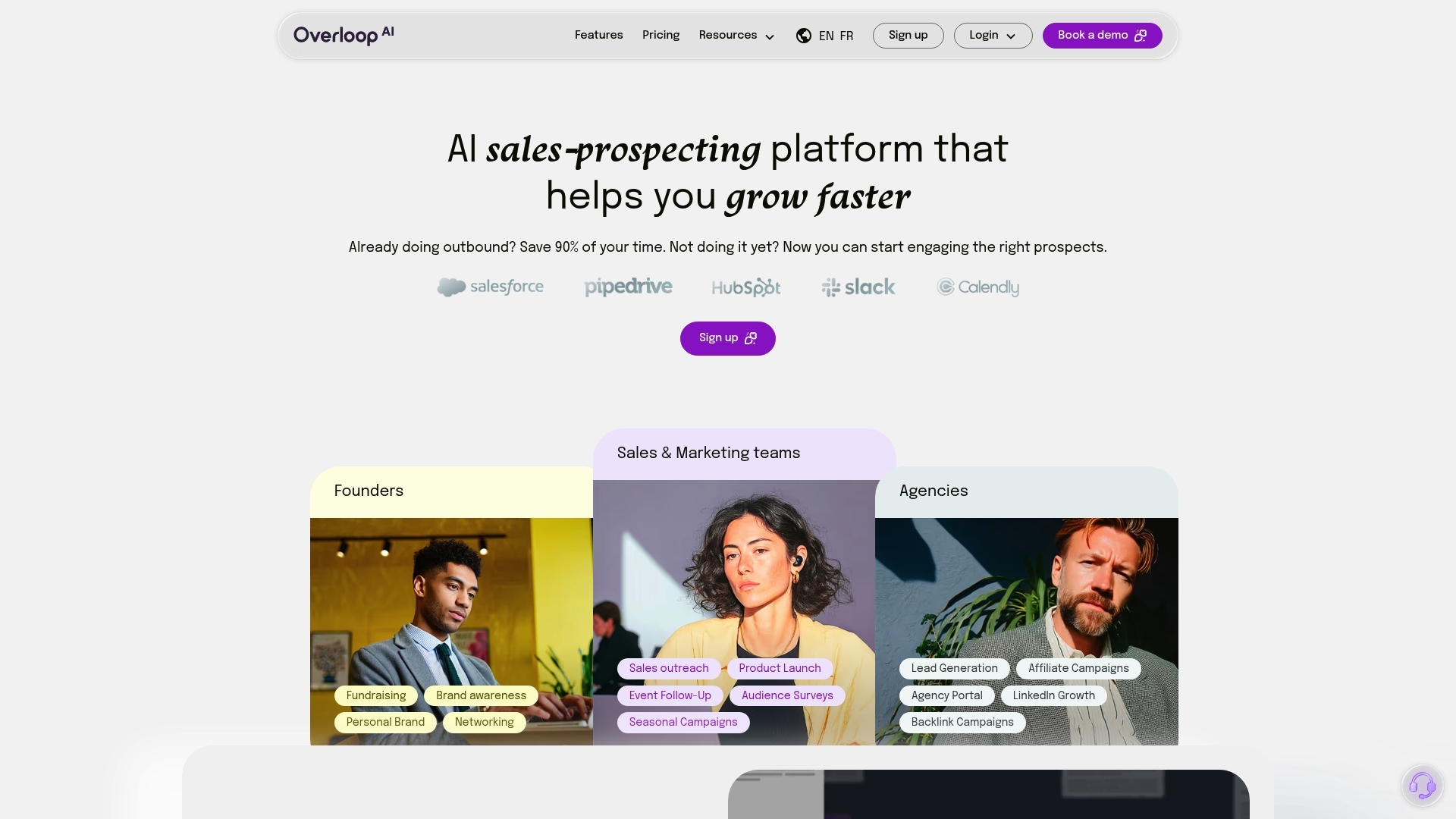Manual prospecting slows down B2B teams and often leads to missed deals, data gaps, and scattered information across different tools. Sales software changes this by offering automation, real-time lead tracking, and integrated features designed for startups aiming to scale quickly.
Sales tools now automate tedious lead sourcing and identify potential clients with precise criteria rather than endless spreadsheets. Instead of spending hours searching for prospects and personalizing messages individually, platforms like Overloop use AI to build lead lists and generate unique outreach for every contact. This increases productivity and lets teams focus on building relationships and closing deals rather than copying data and following up manually.
An organized approach also solves tracking and campaign visibility challenges. Sales software tracks every touchpoint and interaction, so you always see what works and where leads stand in the pipeline. Integrated analytics highlight opportunities for better conversions and prevent revenue from slipping through the cracks.
Startups and B2B teams using automation avoid scaling issues and manual overhead. By combining lead generation, campaign tools, and CRM integrations in one place, modern sales software makes it possible to grow your pipeline efficiently and maintain data consistency across all activities.
Understanding the Core Challenges of B2B Lead Generation
B2B sales teams often feel slowed down by the repetitive and manual process of prospect sourcing. Finding new contacts, checking for accuracy, and building lists can consume hours every week, leaving little time for engaging with actual leads. This manual searching creates a significant bottleneck and limits how fast a startup can scale its sales outreach.
After you gather contacts, more challenges surface. Many teams face low visibility into campaign performance. Without clear insights into which prospects interact with your messages, it is nearly impossible to adjust campaigns in real time or improve response rates. Actions like tracking email opens, link clicks, and call history are often siloed across different apps. This fragmented data prevents accurate attribution and slows down reporting, making it hard to see what actually delivers results.
Disconnected tools compound these problems. Sales teams frequently juggle CRMs, email finders, enrichment platforms, and LinkedIn lists, leading to messy workflows and lots of manual data entry. Using non-integrated sales platforms increases the risk of mistakes and drains time from other high-impact activities.
Email deliverability is another core concern. If outreach campaigns cause emails to land in spam folders, lead quality drops. Many sales teams struggle to monitor sender reputation and comply with technical standards, especially without integrated alerts or automatic checks. Solutions like Overloop help address these risks by automatically checking email validity and deliverability before launching campaigns, making it easier for teams to send outreach safely and reliably.
How Sales Software Solves Prospecting and Lead Generation Pain Points
Traditional prospecting often means searching directories and piecing together email lists, taking valuable hours away from direct selling. Sales software ends this cycle by automating lead sourcing based on your predefined criteria, so you receive lists of potential clients ready for outreach without manual research.
Automatic Lead Sourcing
Platforms like Overloop connect to large B2B databases with hundreds of millions of verified contacts. You define your ideal customer profile, then the software instantly builds a list of qualified leads. This process skips manual data entry and ensures contacts are always fresh and up to date.
Targeting Warm Leads With Data
Modern sales tools analyze behavioral signals and previous interactions to flag contacts most likely to engage. You can filter leads by job title, industry, company size, location, and engagement history, focusing effort on prospects who match your product and who are more open to a conversation.
Streamlining Outreach With AI Personalization
Personalization is crucial for cold outreach but difficult to scale manually. Advanced platforms use AI to generate custom email messages for each lead, referencing unique details from the lead’s profile or company. Overloop, for example, auto-writes outreach in over 80 languages, adjusting tone and context for every recipient. Multi-channel support allows for synchronized email and LinkedIn contact, increasing the chance to get replies while saving your team from repetitive tasks.
Leveraging Automation and AI for Outreach and Campaign Management
After addressing prospecting barriers and visibility gaps, many B2B teams move to automating outreach and campaign workflows. Automation tools take over repetitive tasks, saving time and removing errors from manual handling. This shift allows your sales team to maintain higher speed and personalization in all outbound activities.
Building Automated Outreach Workflows
To start, map out every step in your outreach process. Typical steps include:
- Segmentation and import of lead lists
- Personalized email and LinkedIn message sequencing
- Scheduling follow-up reminders and drip campaigns
- Tracking opens, clicks, and replies
Sales software lets you automate these stages in a single flow. For example, users can create a multi-touch sequence where contacts first receive a personalized email and then a LinkedIn invite if they do not respond. These rules can be set up once and applied across all campaigns, reducing repetition and improving consistency.
Using AI for Better Personalization and Timing
Modern platforms, like Overloop, use AI to analyze each prospect’s profile and interaction history. This helps generate tailored messages and choose the best send times. AI-driven personalization increases the likelihood of engagement by referencing the recipient’s company, role, or recent news. Teams can also use templates that dynamically insert custom snippets or pull details from other data sources.
By combining automation with advanced personalization, startups can manage high-volume campaigns while maintaining a human tone. This approach frees up your team for more strategic work and enables faster scaling without increased manual labor.
Integrating Sales Software With Your Existing Stack
Disconnected sales and marketing tools can lead to duplicate work and mismatched data, causing confusion about lead status and campaign results. To maintain accuracy and prevent unnecessary manual entry, it is essential that sales software integrates smoothly with your existing systems such as CRMs, communication tools, and scheduling solutions.
Benefits of Connecting Your Tools
Seamless integration offers several advantages:
- Consistent contact records across platforms
- Automated syncing of lead activity and communication logs
- Elimination of redundant data entry between tools
- Clear visibility into sales pipeline, touchpoints, and outcomes
For growing startups, the right sales platform will support direct connections with widely used systems like Salesforce, HubSpot, or Pipedrive. This means updates made in one application flow automatically to others, so your team never needs to manually export, import, or copy data again.
Overloop, for example, allows users to sync leads, deals, and campaign results with major CRMs, as well as automate calendar scheduling and enable instant alerts in messaging apps like Slack. By centralizing these workflows, teams avoid process silos and wasted time, resulting in faster lead follow-ups and more reliable sales reporting. Explore more about Overloop’s key features for streamlined integrations.
Integrating your tech stack supports accuracy and efficiency, making high-volume prospecting and nurturing practical for startups aiming to grow without increased admin overhead.
Ensuring Accurate Tracking and Data Management
Accurate sales tracking starts with unified data management. When contacts, companies, and activities live in scattered spreadsheets or siloed tools, your team risks missing key conversations, duplicating outreach, or relying on out-of-date information. Sales software organizes everything in one place, making every lead, task, and email easy to find and track.
Key Elements for Reliable Tracking
Unified contact records capture full lead history, including past conversations and touchpoints from both email and LinkedIn. This lets your team see where each prospect is in the sales cycle and avoids repeated messages to the same contact.
Automatic activity tracking means every call, email, and note is logged in real-time without manual updates. With platforms like Overloop, every step from first outreach to final deal is attached to the same contact, so reporting never misses important details. Teams gain visibility into who responded, which templates work best, and where drop-offs happen.
Startups benefit from actionable analytics that break down open rates, reply rates, and conversion by channel. Visual reports make it clear what activities deliver results, helping teams double down on what works and adjust where needed. Instead of guessing, you use precise metrics to guide decisions and boost conversions.
Effective tracking and consistent records make it easier for new team members to jump in and for startups to scale without data chaos. When all lead activity is linked, your workflow stays clean, and your sales pipeline remains predictable.
Mitigating Email Deliverability Risks With Smart Sales Software
Email deliverability is crucial for maintaining reliable contact with leads and ensuring that your outreach does not end up in spam folders. Key factors influence whether recipients see your emails in their main inbox or ignore them, including sender reputation, technical authentication, email content, and list quality.
Best Practices for Maintaining Deliverability
- Authenticate your sending domain using SPF, DKIM, and DMARC. These protocols tell mailbox providers that your emails are legitimate.
- Warm up new domains by gradually increasing the volume of sent messages.
- Use only verified, permission-based email lists to reduce bounce rates and spam complaints.
- Limit the volume of manual follow-ups to avoid triggering spam filters.
- Regularly clean your contact lists, removing invalid or unengaged addresses.
- Monitor open, click, bounce, and unsubscribe rates, adjusting campaigns accordingly.
Modern sales software simplifies these best practices. For instance, automated email verification checks, like those built into Overloop, confirm the validity of contacts before you send to them. The software also recognizes risky sending patterns, warns users before issues arise, and adapts sending limits based on engagement. Built-in compliance helps with GDPR and other regulations by tracking unsubscribes and automating removal.
By integrating these safeguards, teams reduce deliverability risks while focusing on nurturing prospects. Sales platforms help startups avoid technical pitfalls and maintain a high sender reputation for better outreach results.
Overloop: Automating B2B Sales for Modern Teams

Finding ways to scale sales and boost lead generation efficiency matters most for startups and agile B2B teams. Relying on disconnected tools or manual outreach often slows team momentum and fragments pipeline visibility. Overloop approaches these pain points with AI automation built for end-to-end lead management, so every step in the outbound process connects in one place.
AI-Driven Lead Sourcing and Smart Personalization
Automatic access to a global B2B database gives users a fast start on building prospect lists that fit precise filters. Overloop’s AI-driven engine handles both identification and verification of contact information, removing the need for manual list creation or separate email validation tools. Equipped with context-aware personalization, the platform can generate outbound messages in over 80 languages that mirror each recipient’s unique data points like company, job title, or recent activities.
Automated Multi-Channel Outreach and Deliverability Protection
Teams can quickly deploy campaign sequences across email and LinkedIn, aligning multiple touchpoints into a single automated workflow. Set-and-forget scheduling options mean follow-ups happen even if contacts do not reply after an initial message. The integrated deliverability checker continuously monitors sender reputation, prevents risky behaviors, and helps keep outreach away from spam folders. Read more Overloop customer stories on how businesses reach their growth targets.
Seamless Workflow Integration and Activity Tracking
Connections with popular CRMs and scheduling tools support consistent records and swift updates, so data does not become siloed or outdated. Real-time activity analytics reveal performance insights at each campaign stage, letting users optimize strategies as they grow their pipeline. For startups needing rapid feedback and minimal manual upkeep, these features combine to reduce time investment, raise productivity, and scale results without complexity.
Best Practices: Increasing Productivity and Conversion With Sales Software
Getting the most from sales software requires a clear, stepwise approach. Strategic setup and consistent habits lead to higher productivity and better conversion rates for startups and B2B teams alike.
Step-by-Step Guide to Using Sales Software Effectively
- Define Precise Lead Criteria: Start with a sharply defined ideal customer profile including industry, role, and company size. This focus ensures targeting relevant prospects and improves list quality from the outset.
- Automate Lead Sourcing: Use built-in prospecting features to generate qualified lead lists automatically. Platforms like Overloop offer large, verified databases so teams avoid the burden of manual research.
- Personalize Outreach at Scale: Set up AI-driven workflows that craft custom messages referencing each prospect’s background. Leverage dynamic fields and templates to maintain personalization without extra effort.
- Create Multi-Channel Campaigns: Combine email and LinkedIn messaging sequences within your campaign structure. Multi-channel strategies increase response rates and keep follow-ups timely.
- Integrate With Your Current Tools: Sync your software with CRM, scheduling, and communication platforms. Automated data sharing avoids duplicates and keeps all records accurate.
- Track, Review, and Optimize Regularly: Monitor real-time analytics to surface trends in open, reply, and conversion rates. Adjust templates or targeting rules as insights emerge to improve future outreach.
By following these streamlined steps, startups lower manual overhead and create space for strategic selling. Consistent use of features, such as automated deliverability protection, supports higher conversion and allows teams to grow outreach without introducing chaos or data risk.
Frequently Asked Questions About Sales Software for B2B Teams
B2B startups and growing sales teams usually have questions about adopting new software to manage lead generation and tracking. Here are direct answers to common topics about sales and tracking platforms.
How Easy Is It to Set Up and Use Sales Software?
Most modern sales tools provide an intuitive setup process. After signing up, users select target criteria and connect email or LinkedIn accounts. Platforms like Overloop streamline onboarding by guiding teams through list creation, outreach workflow setup, and integration steps, usually without significant technical knowledge needed.
Does Sales Software Integrate With Existing CRM and Productivity Tools?
Integration with leading CRMs like Salesforce, HubSpot, or Pipedrive is standard among reputable solutions. Connecting your stack automatically syncs leads and campaign updates, reducing manual entry. Many sales platforms support plug-and-play integrations with popular tools such as Slack or Calendly to keep records and conversations consistent.
What Are the Hard Benefits for Startups?
- Automated prospect sourcing saves hours each week
- Personalized outreach increases response rates
- Unified data prevents lost contacts and follow-up errors
- Analytics highlight best-converting activities
These benefits combine to build a repeatable, scalable outbound process with less manual work and higher productivity. See examples of ROI in real customer success stories.
What Are the Main Risks and How Are They Managed?
Risks include poor deliverability, data errors, and disjointed workflows. Quality sales platforms address these with built-in email checks, GDPR features, and automated workflow monitoring. To limit issues, always use permission-based contact lists and maintain regular list cleaning practices. Relying on tools with integrated protections, like Overloop, reduces setup risks and helps sustain consistent results.
Conclusion: Scaling B2B Sales Success Through Modern Software Solutions
Scaling B2B lead generation and tracking comes down to addressing long-standing sales challenges with the right workflows and tools. As seen throughout this guide, manual prospecting, disconnected applications, and unreliable tracking lead to wasted hours and missed deals. When startups implement platforms that unify lead sourcing, campaign management, and data analytics, they convert more opportunities with less manual effort.
Driving Sustainable Sales Growth With Modern Platforms
Sales teams that automate repetitive tasks see improvements in both productivity and conversion rates. Moving to a software-powered process eliminates time-consuming list building, ensures messages are relevant without added effort, and protects against common risks like spam filtering or outdated records. Consistent integration with CRM and outreach tools preserves data accuracy so your campaigns always start from a reliable foundation.
Adopting comprehensive solutions helps startups and fast-moving B2B teams maintain agility even as operations expand. By centralizing pipeline management and embracing automation, teams create a predictable system that supports continuous growth.
Next Steps for Startups and B2B Teams
- Evaluate which lead generation processes drain the most time and energy
- Seek out software integrating prospecting, outreach, and analytics in one standardized workflow
- Prioritize tools with AI-driven personalization, reliable compliance, and seamless connections with your tech stack
For teams ready to move from tedious manual work to efficient, results-driven sales, platforms like Overloop streamline every aspect of outbound activity. These solutions empower startups to focus less on administration and more on closing meaningful deals, making sustainable scaling achievable with fewer resources.


